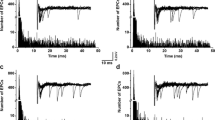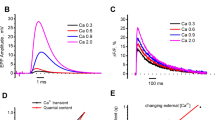Abstract
The local calcium concentration in the active zone of secretion determines the number and kinetics of neurotransmitter quanta released after the arrival of a nerve action potential in chemical synapses. The small size of mammalian neuromuscular junctions does not allow direct measurement of the correlation between calcium influx, the state of endogenous calcium buffers determining the local concentration of calcium and the time course of quanta exocytosis. In this work, we used computer modeling of quanta release kinetics with various levels of calcium influx and in the presence of endogenous calcium buffers with varying mobilities. The results of this modeling revealed the desynchronization of quanta release under low calcium influx in the presence of an endogenous fixed calcium buffer, with a diffusion coefficient much smaller than that of free Ca2+, and synchronization occurred upon adding a mobile buffer. This corresponds to changes in secretion time course parameters found experimentally (Samigullin et al., Physiol Res 54:129–132, 2005; Bukharaeva et al., J Neurochem 100:939–949, 2007).










Similar content being viewed by others
Abbreviations
- TCS:
-
time course of secretion
- BAPTA-AM:
-
1,2-bis(2-aminophenoxy)ethane-N,N,N,N-tetraacetic acid tetrakis acetoxymethyl ester
References
Ahmed, Z., & Connor, J. (1988). Calcium regulation by and buffer capacity of molluscan neurons during calcium transients. Cell Calcium, 9, 57–69.
Allana, T., & Lin, J.-W. (2004). Relative distribution of Ca2+ channels at the crayfish inhibitory neuromuscular junction. Journal of Neurophysiology, 92, 1491–5000.
Augustine, G. J. (2001). How does calcium trigger neurotransmitter release? Current Opinion in Neurobiology, 11, 320–326.
Augustine, G. J., & Neher, E. (1992a). Calcium requirements for secretion in bovine chromaffin cells. Journal of Physiology, 450, 247–271.
Augustine, G. J., & Neher, E. (1992b) Neuronal Ca2+ signaling takes the local route. Current Opinion in Neurobiology, 2, 302–307.
Barrett, E. F., & Stevens, C. F. (1972). The kinetics of transmitter release at the frog neuromuscular junction. Journal of Physiology, 227, 691–708.
Bennett, M. R., Farnell, L., & Gibson, W. G. (2000). The probability of quantal secretion near a single calcium channel of an active zone. Biophysical Journal, 78, 2201–2221.
Bi, G., & Poo, M. (1998). Synaptic modifications in cultured hippocampal neurons: Dependence on spike timing, synaptic strength, and postsynaptic cell type. Journal of Neuroscience, 18, 10464–10472.
Bukharaeva, E., Samigullin, D., Nikolsky, E., & Magazanik, L. (2007). Modulation of the kinetics of evoked quantal release at mouse neuromuscular junctions by calcium and strontium. Journal of Neurochemistry, 100, 939–949.
Bukharaeva, E., Samigullin, D., Nikolsky, E., & Vyskočil, F. (2002). Protein kinase A cascade regulates quantal release dispersion at frog muscle endplate. Journal of Physiology, 538, 837–848.
Burnashev, N., & Rozov, A. (2005). Presynaptic Ca2+ dynamics, Ca2+ buffers and synaptic efficacy. Cell Calcium, 37, 489–495.
Chow, R., Klingauf, J., & Neher, E. (1994). Time course of Ca2+ concentration triggering exocytosis in neuroendocrine cells. Proceedings of the National Academy of Sciences of the United States of America, 91, 12765–12769.
Collin, T., Chat, M., Lucas, M., Moreno, H., Racay, P., Schwaller, B., et al. (2005). Developmental changes in parvalbumin regulate presynaptic Ca2+ signaling. Journal of Neuroscience, 25, 96–107.
Dodge, J., & Rahamimoff, R. (1967). Co-operative action a Ca2+ in transmitter release at the neuromuscular junction. Journal of Physiology, 193, 419–432.
Glavinovich, M., & Rabie, H. (2001). Monte Carlo evaluation of quantal analysis in the light of Ca2+ dynamics and the geometry of secretion. Pflügers Archiv—European Journal of Physiology, 443, 132–145.
Feher, J., Fulmer, C., & Fritzsch, G. (1989). Comparison of the enhanced steady-state diffusion of calcium by calbindin-D9K and calmodulin, possible importance in intestinal calcium absorption. Cell Calcium, 10, 189–203.
Gabso, M., Neher, E., & Spira, M. (1997). Low mobility of the Ca2+ buffers in axons of cultured Aplysia neurons. Neuron, 18, 473–481.
Giniatullin, R., Kheeroug, L., & Vyskočil, F. (1995). Modelling endplate current: Dependence on quantum secretion probability and postsynaptic miniature current parameters. European Journal of Biophysics, 23, 443–446.
Hilt, D., & Kligman, D. (1991). The S-100 protein family, a biochemical and functional overview. Novel calcium-binding proteins (pp. 65–103). Berlin: Springer.
Katz, B. (1968). The role of calcium in neuromuscular facilitation. Journal of Physiology, 195, 481–492.
Katz, B., & Miledi, R. (1965). The measurement of synaptic delay, and the time course of acetylcholine release at the neuromuscular junction. Proceedings of the Royal Society of London. Series B, Biological Sciences, 161, 483–495.
Kits, K., de Vlieger, T., Kooi, B., & Mansvelder, H. (1999). Diffusion barriers limit the effect of mobile calcium buffers on exocytosis of large dense cored vesicles. Biophysical Journal, 76, 1693–1705.
Klingauf, J., & Neher, E. (1997). Modeling buffered Ca2+ diffusion near the membrane, implications for secretion in neuroendocrine cells. Biophysical Journal, 72, 674–690.
Lee, S., Schwaller, B., & Neher, E. (2000). Kinetics of Ca2+ binding to parvalbumin in bovine chromaffin cells, implications for [Ca2+] transients of neuronal dendrites. Journal of Physiology, 525, 419–432.
Lin, J. W., & Farber, S. (2002). Modulation of synaptic delay during synaptic plasticity. Trends in Neuroscience, 25, 449–455.
Lin, J. W., Fu, Q., & Allana, T. (2005). Probing the endogenous Ca2+ buffers at the presynaptic terminals of the crayfish neuromuscular junction. Journal of Neurophysiology, 94, 377–386.
Markram, H., Lubke, J., Frotscher, M., & Sakmann, B. (1997). Regulation of synaptic efficacy by coincidence of postsynaptic APs and EPSPs. Science, 275, 213–216.
Matveev, V., Sherman, A., & Zucker, R. (2002). New and corrected simulations of synaptic facilitation. Biophysical Journal, 83, 1368–1373.
Matveev, V., Zucker, R., & Sherman, A. (2004). Facilitation through buffer saturation, constraints on endogenous buffering properties. Biophysical Journal, 86, 2691–2709.
Meinrenken, C., Borst, J., & Sakmann, B. (2002). Calcium secretion coupling at Calyx of Held governed by nonuniform channel-vesicle topography. Journal of Neuroscience, 22, 1648–1667.
Muller, A., Kukley, M., Stausberg, P., Beck, H., Muller, W., & Dietrich, D. (2005). Endogenous Ca2+ buffer concentration and Ca2+ microdomains in hippocampal neurons. Journal of Neuroscience, 25, 558–565.
Muller, M., Felmy, F., Schwaller, B., & Schneggenburger, R. (2007). Parvalbumin is a mobile presynaptic Ca2+ buffer in the Calyx of Held that accelerates the decay of Ca2+ and short-term facilitation. Journal of Neuroscience, 27, 2261–2271.
Nauki, H., Sakumura, Y., & Ishii, S. (2005). Local signaling with molecular diffusion as a decoder of Ca2+ signals in synaptic plasticity. Molecular Systems Biology, 1, 0027.
Neher, E. (1995). The use of fura-2 for estimating Ca buffers and Ca fluxes. Neuropharmacology, 34, 1423–1442.
Nowycky, M., & Pinter, M. (1993). Time courses of calcium and calcium-bound buffers following calcium influx in a model cell. Biophysical Journal, 64, 77–91.
Parnas, H., Dudel, J., & Parnas, I. (1986). Neurotransmitter release and its facilitation in crayfish. V. Another voltage-dependent process beside Ca entry controls the time course of phasic release. Pflügers Archiv, 406, 121–130.
Sabatini, B., & Regehr, W. (1999). Timing of synaptic transmission. Annuual Review Physiology, 61, 521–42
Sala, F., & Hernandez-Cruz, A. (1990). Calcium diffusion modeling in a spherical neuron. Relevance of buffering properties. Biophysical Journal, 57, 313–324.
Samigullin, D., Bukharaeva, E., Vyskočil, F., & Nikolsky, E. (2005). Calcium dependence of uni-quantal release latencies and quantal content at mouse neuromuscular junction. Physiological Researches, 54, 129–132.
Schmidt, H., Stiefel, K., Racay, P., Schwaller, B., & Eilers, J. (2003). Mutational analysis of dendritic Ca2+ kinetics in rodent Purkinje cells, role of parvalbumin and calbindin D28k. Journal of Physiology, 551, 13–32.
Schneggenburger, R., & Neher, E. (2000). Intracellular calcium dependence of transmitter release rates at a fast central synapse. Nature, 406, 889–893.
Schneggenburger, R., & Neher, E. (2005). Presynaptic calcium and control of vesicle fusion. Current Opinion in Neurobiology, 15, 266–274.
Segura, J., Gil, A., & Soria, B. (2000). Modeling study of exocytosis in neuroendocrine cells, influence of the geometrical parameters. Biophysical Journal, 79, 1771–1786.
Shahrezaei, V., & Delaney, K. R. (2004). Consequences of molecular-level Ca2+ channel and synaptic vesicle colocalization for the Ca2+ microdomain and neurotransmitter exocytosis: A Monte Carlo study. Biophysical Journal, 87, 2352–2364.
Shahrezaei, V., Cao, A., & Delaney, K. (2006). Ca2+ from one or two channels controls fusion of a single vesicle at the frog neuromuscular junction. Journal of Neuroscience, 26, 13240–13249.
Soucek, B. (1971). Influence of latency fluctuations and the quantal process of transmitter release on the end-plate potential’s amplitude distribution. Biophysical Journal, 11, 127–139.
Stockbridge, N., & Moore, J. (1984). Dynamics of intracellular calcium and its possible relationship to phasic transmitter release and facilitation at the frog neuromuscular junction. Journal of Neuroscience, 4, 803–811.
Stuenkel, E. (1994). Regulation of intracellular calcium and calcium buffering properties of rat isolated neurohypophysial nerve endings. Journal of Physiology, 481, 251–271.
Tang, Y., Schlumpberger, T., Kim, T., Lueker, M., & Zucker, R. (2000). Effects of mobile buffers on facilitation, experimental and computational studies. Biophysical Journal, 78, 2735–2751.
Van der Kloot, W. (1988). The kinetics of quantal releases during end-plate currents at the frog neuromuscular junction. Journal of Physiology, 402, 605–626.
Yamada, W., & Zucker, R. (1992). Time course of transmitter release calculated from simulations of a calcium diffusion model. Biophysical Journal, 61, 671–682.
Zhou, Z., & Neher, E. (1993). Mobile and immobile calcium buffers in bovine adrenal chromaffine cells. Journal of Physiology, 469, 245–273.
Acknowledgments
We thank Dr. Maria Bykhovskaia and Dr. Andrey Skorinkin for critical reading of the manuscript. Supported by GAAVA5011411, GACR305/02/1333, and MSMT11310003 for FV, by RFBR 08-04-00923, Russian Scientific Schools—4177.2008.4 for EN, by “Russian Science Support Foundation” for DS, by US Civilian Research and Development Foundation (RUB1-2823-KA06) for EB and DS.
Author information
Authors and Affiliations
Corresponding author
Additional information
Action Editor: Upinder Bhalla
Rights and permissions
About this article
Cite this article
Gilmanov, I.R., Samigullin, D.V., Vyskočil, F. et al. Modeling of quantal neurotransmitter release kinetics in the presence of fixed and mobile calcium buffers. J Comput Neurosci 25, 296–307 (2008). https://doi.org/10.1007/s10827-008-0079-5
Received:
Revised:
Accepted:
Published:
Issue Date:
DOI: https://doi.org/10.1007/s10827-008-0079-5




